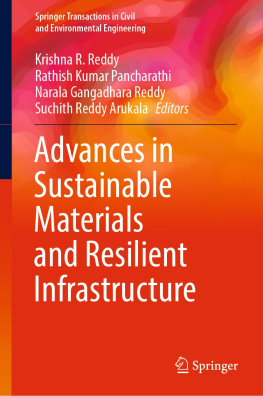World Scientific Series in Current Energy Issues
Series Editor: Gerard M Crawley (University of South Carolina & Marcus Enterprise LLC, USA)
Published
Vol. 5 Critical Materials: Underlying Causes and Sustainable Mitigation Strategies
edited by S Erik Offerman
Vol. 4 Energy Storage
edited by Gerard M Crawley
Vol. 3 Energy from the Nucleus: The Science and Engineering of Fission and Fusion
edited by Gerard M Crawley
Vol. 2 Solar Energy
edited by Gerard M Crawley
Vol. 1 Fossil Fuels: Current Status and Future Directions
edited by Gerard M Crawley
Published by
World Scientific Publishing Co. Pte. Ltd.
5 Toh Tuck Link, Singapore 596224
USA office: 27 Warren Street, Suite 401-402, Hackensack, NJ 07601
UK office: 57 Shelton Street, Covent Garden, London WC2H 9HE
Library of Congress Cataloging-in-Publication Data
Names: Offerman, S. Erik, editor.
Title: Critical materials : underlying causes and sustainable mitigation strategies /
S. Erik Offerman, Delft University of Technology, The Netherlands.
Description: New Jersey : World Scientific, [2018] | Series: World Scientific series in
current energy issues ; volume 5 | Includes bibliographical references and index.
Identifiers: LCCN 2018028408 | ISBN 9789813271043 (hardcover)
Subjects: LCSH: Raw materials--Research. | Strategic materials--Research. |
Mineral industries--Environmental aspects. | Sustainable engineering.
Classification: LCC TA404.2 .O43 2018 | DDC 333.8--dc23
LC record available at https://lccn.loc.gov/2018028408
British Library Cataloguing-in-Publication Data
A catalogue record for this book is available from the British Library.
Copyright 2019 by Author
This is an Open Access ebook published by World Scientific Publishing Company and distributed under the terms of the Creative Commons Atribution (CC-BY) Licence.
For any available supplementary material, please visit
https://www.worldscientific.com/worldscibooks/10.1142/11007#t=suppl
Typeset by Stallion Press
Email:
Printed in Singapore
Foreword to the World Scientific Series on Current Energy Issues
Sometime between four hundred thousand and a million years ago, an early humanoid species developed the mastery of fire and changed the course of our planet. Still, as recently as a few hundred years ago, the energy sources available to the human race remained surprisingly limited. In fact, until the early nineteenth century, the main energy sources for humanity were biomass (from crops and trees), their domesticated animals and their own efforts.
Even after many millennia, the average per capita energy use in 1830 only reached about 20 Gigajoules (GJ) per year. By 2010, however, this number had increased dramatically to 80 GJ per year. One reason for this notable shift in energy use is that the number of possible energy sources increased substantially during this period, starting with coal in about the 1850s and then successively adding oil and natural gas. By the middle of the twentieth century, hydropower and nuclear fission were added to the mix. As we move into the twenty-first century, there has been a steady increase in other forms of energy such as wind and solar, although presently they represent a relatively small fraction of world energy use.
Despite the rise of a variety of energy sources, per capita energy use is not uniform around the world. There are enormous differences from country to country, pointing to a large disparity in wealth and opportunity. (See Table 1) For example, in the United States the per capita energy use per year in 2011 was 312.8 million Btu The general trends over the last decade suggest that countries with developed economies generally show modest increases or even small decreases in energy use, but that developing economies, particularly China and India, are experiencing rapidly increasing energy consumption per capita.
Table 1: Primary Energy Use Per Capita in Million Btu (MMBtu).
These changes, both in the kind of resource used and the growth of energy use in countries with developing economies, will have enormous effects in the near future, both economically and politically, as greater numbers of people compete for limited energy resources at a viable price. A growing demand for energy will have an impact on the distribution of other limited resources such as food and fresh water as well. All this leads to the conclusion that energy will be a pressing issue for the future of humanity.
Another important consideration is that all energy sources have disadvantages as well as advantages, risks as well as opportunities, both in the production of the resource and in its distribution and ultimate use. Coal, the oldest of the new energy sources, is still used extensively to produce electricity, despite its potential environmental and safety concerns in mining both underground and open cut mining. Burning coal releases sulphur and nitrogen oxides which in turn can leads to acid rain and a cascade of detrimental consequences. Coal production requires careful regulation and oversight to allow it to be used safely and without damaging the environment. Even a resource like wind energy using large wind turbines has its critics because of the potential for bird kill and noise pollution. Some critics also find large wind turbines an unsightly addition to the landscape, particularly when the wind farms are erected in pristine environments. Energy from nuclear fission, originally believed to be too cheap to meter has not had the growth predicted because of the problem with long term storage of the waste from nuclear reactors and because of the public perception regarding the danger of catastrophic accidents such as happened at Chernobyl in 1986 and at Fukushima in 2011.
Even more recently, the measured amount of carbon dioxide, a greenhouse gas, in the global atmosphere has steadily increased and is now greater than 400 parts per million (ppm). that this increase in CO will produce an increase in global temperatures. We will see a rise in ocean temperature, acidity and sea level, all of which will have a profound impact on human life and ecosystems around the world. Relying primarily on fossil fuels far into the future may therefore prove precarious, since burning coal, oil and natural gas will necessarily increase CO levels. Certainly for the long term future, adopting a variety of alternative energy sources which do not produce CO seems to be our best strategy.
The volumes in the World Scientific Series on Current Energy Issues explore different energy resources and issues related to the use of energy. The volumes are intended to be comprehensive, accurate, current, and include an international perspective. The authors of the various chapters are experts in their respective fields and provide reliable information that can be useful to scientists and engineers, but also to policy makers and the general public interested in learning about the essential concepts related to energy. The volumes will deal with the technical aspects of energy questions but will also include relevant discussion about economic and policy matters. The goal of the series is not polemical but rather is intended to provide information that will allow the reader to reach conclusions based on sound, scientific data.












